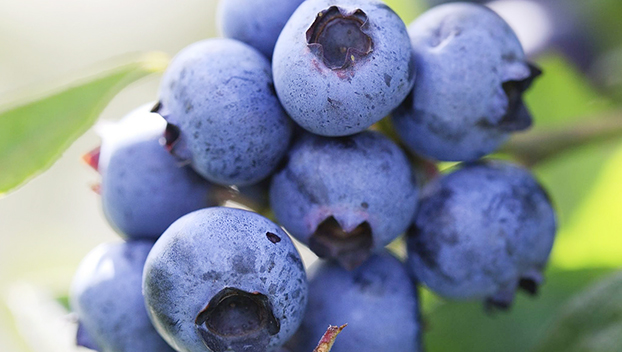CERTIFIED TEXAS EXPERT GARDENER — It’s harvest time. Grab a pail and pick blueberries.
Published 12:02 am Wednesday, May 15, 2024

- A pristine cluster of “Brightwell” blueberries are bursting with flavor and ready to harvest. Gather them when the entire berry has a dark blue color with no other colors present on the berry, since blueberries will not ripen further after harvesting. (Courtesy photo)
|
Getting your Trinity Audio player ready...
|
Gardner’s in case you haven’t noticed, blueberry bushes are brimming with succulent, round berries bursting with flavor (we have picked several pounds of fruit which freeze well too).
For us, harvesting season for these magnificent fruits begins at the beginning of May and often ends late July, with a few stragglers ripening into August. Gather them when the entire berry has a dark blue color with no other colors present on the berry, since blueberries will not ripen further after harvesting.
Harvest berries every 2 to 5-days as they ripen and keep a watchful eye for “berry predators,” noting that our winged friends enjoy them as much as we do! Netting is a deterrent to winged marauders and is effective (highly recommended).
Trending
Cover each plant with netting before berries begin to ripen to protect them and maintain your harvest. If you enjoy blueberries and want the best tasting fruits possible, there are numerous “U-Pick” blueberry farms easily accessible for most of us.
It is a wonderful and rewarding experience for your family to enjoy, with the added benefit of harvesting the best quality berries possible!
Over the years as we have relocated due to career moves and have enjoyed visiting numerous “U-Pick” farms in Alabama, California, and Texas picking strawberries, plums, apricots, figs and one of my personal favorites-blueberries. Of course, there is another option (though it will take a bit longer) but can be just as rewarding: plant and harvest your own blueberries!
Before planting blueberries, it is imperative to have a soil analysis performed to understand the soil amendments needed to provide blueberries’ ideal growing conditions, as they have specific requirements which must be provided.
As gardeners, we know there are numerous plant exceptions we as gardeners should be mindful of, plants that require specific soil types, such as acidic soil in which to thrive. There is an array of plants classified as ‘acid-loving’ plants which include most evergreens, rhododendron, hydrangea, camelia, azalea, and you guessed it-blueberry.
Blueberry plants are native to North America and for our locale the best types are rabbiteye blueberries (Vaccinium ashei), a mature plant can produce up to 15 pounds of fruit per season.
Trending
The southern highbush blueberries (hybrids of Vaccinium corymbosum, V. ashei and V. darrowii) require fewer ‘chill’ hours, and bloom earlier in spring than rabbiteyes, but are susceptible to damage by late frosts. I’ve chosen to plant three different varieties of rabbiteye blueberries due to our ever changing environmental conditions and have not been disappointed! The Southern highbush varieties tend to provide fruit sooner (up to a month earlier) than rabbiteye blueberries and having both varieties will extend fruit availability.
Common rabbiteye varieties include ‘Brightwell’, ‘Austin’, ‘Premier,’ and ‘Vernon.’ For maximize fruit set and to increase yields a minimum of two different varieties must been planted. There are a couple varieties which are slightly self-fruitful but produce better yields with another variety for cross pollination.
Blueberry flowers are bell-shaped, whitish pink in color, hanging upside-down and require insects to pollinate each flower. The best time to plant is winter through early spring, bare-root, or container-grown plants (my preference). One of the biggest mistakes gardeners make when planting blueberries is planting them too deeply.
The plants have very fine, sensitive, fibrous root systems which will not recover if planted too deeply. All blueberries require acidic soil and thrive when the pH range is maintained between 4.5–5.5. Our clay soil tends to be more alkaline (having a higher pH) than the ideal range required by blueberries but also retains too much moisture, so consider growing them in raised beds or containers.
This gardener filled several large (150-gallon) livestock water troughs (note: 2-inch holes were drilled into the bottom of each for drainage) and then filled each with a mix of peat moss and partially composted pine bark in multiple layers. Alternating peat moss and composted pine bark. Using a garden spade, turn the layers and moisten each layer as you build the container or raised bed.
Do not crowd blueberries, I planted two plants into each of the 150-gallon containers. A raised bed can be made approximately two feet tall and three feet wide. If growing in individual containers, remember the bigger the container, the better, the more bountiful harvest! Good drainage is critical!
Blueberries root systems are highly sensitive to fertilizer, care must be taken to not apply too much at any given time. My recommendation is to use products specifically formulated for blueberries or azaleas at half the recommended application rate.
They are also sensitive to drought conditions, especially during the first year, so moisture levels must be managed, i.e., don’t keep the soil saturated nor let the soil completely dry out, especially when the plants are loaded with fruit or during our summer months.
Blueberries’ shallow root systems don’t require deep watering but benefit from a mulch layer, minimizing moisture loss due to evaporation. Applying a 2 or 3-inch layer of organic mulch (pine straw or pine bark) to soil surface is the key to successful blueberry production.
Blueberries do not ripen at once, with each cluster of fruit having berries at varying stages of ripeness. For the best quality and maximum ripeness, pick berries that are entirely blue (no hint of red).
Blueberries do not get sweeter after harvesting, so harvest them as they ripen (daily) before the birds harvest them for you! Birds can be problematic, enjoying the fruit as much we do, so consider purchasing bird netting to cover your plants before fruit begins to ripen.
Blueberries are easy to grow when provided with the optimum growing conditions, variety selection and soil preparation with few pests requiring little fertilizer.
Blueberries don’t like clay soil or standing water, but don’t let this be a deterrent to stop you from growing them! They perform admirably in raised beds and large containers with a little TLC and the right soil mix!
Send Certified Texas Expert Gardener John Green your questions and please continue sending comments to jongreene57@gmail.com.





